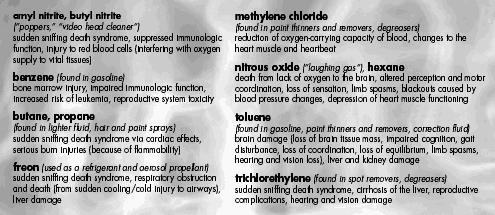
Inhalant abusers risk an array of devastating medical consequences. Prolonged sniffing of the highly concentrated chemicals in solvents or aerosol sprays can induce irregular and rapid heart rhythms and lead to heart failure and death within minutes of a session of prolonged sniffing. This syndrome, known as "sudden sniffing death," can result from a single session of inhalant use by an otherwise healthy young person. Sudden sniffing death is particularly
associated with the abuse of butane, propane, and chemicals in aerosols. Inhalant abuse also can cause death by:
- Asphyxiation - from repeated inhalations, which lead to high concentrations of inhaled fumes displacing
the available oxygen in
the lungs;
- Suffocation - from blocking air from entering the lungs when inhaling fumes from
a plastic bag placed over
the head;
- Convulsions or seizures - caused by abnormal
electrical discharges in the brain;
- Coma - the brain shuts down all but the most vital functions;
- Choking - from inhalation of vomit after inhalant use; or
- Fatal injury - from accidents, including motor vehicle fatalities, suffered while intoxicated.
Animal and human research shows that most inhalants are extremely toxic. Perhaps the most significant toxic effect of chronic exposure to inhalants is widespread and long-lasting
damage to the brain and other parts of the
nervous system.
For example, both animal research
and human
pathological
studies indicate
that chronic abuse of volatile solvents such as toluene damages the
protective sheath around certain nerve fibers in
the brain and peripheral nervous system. This extensive destruction
of nerve fibers is clinically similar
to that seen with neurological
diseases such as multiple sclerosis.
The neurotoxic effects of
prolonged inhalant abuse include neurological syndromes that reflect damage to parts of the brain involved in controlling cognition, movement, vision, and hearing. Cognitive abnormalities can range from mild impairment to severe dementia. Other effects can include difficulty coordinating movement, limb spasms, and loss of feeling, hearing, and vision.
Inhalants also are highly
toxic to other organs. Chronic exposure can produce significant damage to the heart, lungs, liver, and kidneys. Although some inhalant-induced damage to the nervous and other organ systems may be at least partially reversible when inhalant abuse is stopped, many syndromes caused by repeated or prolonged abuse
are irreversible.
Abuse of inhalants during pregnancy also may place infants and children at increased risk of developmental harm. Animal studies designed to simulate human patterns of inhalant abuse suggest that prenatal exposure
to toluene or trichlorethylene (TCE) can result in reduced birth weights, occasional skeletal abnormalities, and delayed
neurobehavioral development.
A number of case reports note abnormalities in newborns of mothers who chronically abuse solvents, and there is evidence
of subsequent developmental impairment in some of these children. However, no well-
controlled, prospective study of the effects of prenatal exposure to inhalants in humans has been conducted, and it is not possible to link prenatal exposure to a specific chemical to a specific birth defect or developmental problem.
What are the special risks
for nitrite abusers?
Nitrites are abused mainly by older adolescents and adults. Typically, individuals who abuse nitrites are seeking to enhance sexual function and pleasure. Research shows that abuse of these drugs in this context is associated with unsafe sexual practices that greatly increase the risk of contracting and spreading such infectious diseases as HIV/AIDS and
hepatitis.
Animal research raises the
possibility that there may be a link between abuse of nitrite inhalants and the development and progression of infectious
diseases and tumors. The research indicates that inhaling nitrites depletes many cells in
the immune system and impairs immune system mechanisms that fight infectious diseases. A recent study found that even a relatively small number of exposures to butyl nitrite can produce dramatic increases in tumor incidence and growth rates in animals.
Where can I
get further scientific information
about inhalant abuse?
To learn more about inhalants and other drugs of abuse, contact the National Clearinghouse for Alcohol and Drug Information (NCADI) at
1-800-729-6686. Information
specialists are available to help you locate information and resources.
Fact sheets, including InfoFacts, on the health effects of inhalants, other drugs of abuse, and
other drug abuse topics are
available on the NIDA Web site (www.drugabuse.gov), and can be ordered free of charge in English and Spanish from the National Clearinghouse for Alcohol and Drug Information (NCADI) at ncadi.samhsa.gov.
|
